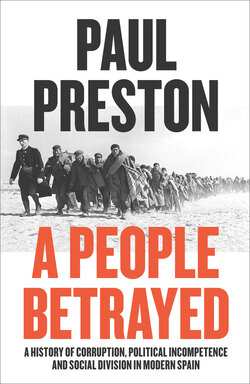A People Betrayed

Реклама. ООО «ЛитРес», ИНН: 7719571260.
Оглавление
Paul Preston. A People Betrayed
Copyright
Dedication
Contents
Preface
1. Spanish Stereotypes? Passion, Violence and Corruption
2. Violence, Corruption and the Slide to Disaster
3. Revolution and War: From the Disaster of 1898 to the Tragic Week of 1909
4. Revolution and War: From the Tragic Week of 1909 to the Crisis of 1917–1918
5. A System in Disarray: Disorder and Repression, 1918–1921
6. From Colonial Disaster to Dictatorship, 1921–1923
7. The Primo de Rivera Dictatorship: The Years of Success, 1923–1926
8. The Primo de Rivera Dictatorship: The Years of Failure, 1926–1931
9. The Second Republic: Reform and Frustration, 1931–1933
10. The Black Years and the Coming of War, 1933–1936
11. Civil War: Hatred, Incompetence and Profit, 1936–1939
12. World War: Survival, Hypocrisy and Profit, 1939–1945
13. The Franco Regime: Corruption and Terror, 1945–1953
14. The Franco Regime: Corruption and Complacency, 1953–1969
15. The Twilight Years of a Corrupt Regime, 1969–1982
16. The Painful Creation of a Democracy, 1975–1982
17. The Grandeur and Misery of a Newborn Democracy, 1982–2004
18. The Triumph of Corruption and Incompetence, 2004–2018
Acknowledgements
Notes
Index
By the Same Author
About the Author
About the Publisher
Отрывок из книги
Linda Palfreeman
.....
Within this authoritarian model, until the 1950s capitalism in Spain was predominantly agrarian except for Asturias, Catalonia and the Basque Country in the north. Spanish agriculture is immensely variegated in terms of climate, crops and land-holding systems. There have long existed areas of commercially successful small and medium-sized farming operations, especially in the lush, wet hills and valleys of those northern regions which also experienced industrialization. However, throughout the nineteenth century and for the first half of the twentieth, the most politically influential sectors were, broadly speaking, the large landowners. In the main, the latifundios, the great estates, are concentrated in the arid central and southern regions of New Castile, Extremadura and Andalusia, although there are also substantial latifundios to be found scattered throughout parts of Old Castile and particularly in Salamanca. The political monopoly of the landed oligarchy saw occasional tentative challenges by the emasculated industrial and mercantile classes. However, reliant on the repressive power of the oligarchy, their efforts met with little success. Until well into the 1950s, the urban haute bourgeoisie was obliged to play the role of junior partner in a working coalition with the great latifundistas. Despite sporadic industrialization and a steady growth in the national importance of the political representatives of the northern industrialists, power remained squarely in the hands of the landowners.
In Spain, industrialization and political modernization did not go hand in hand. In the first half of the nineteenth century, the progressive impulses, both political and economic, of the Spanish bourgeoisie were diverted. The desamortización (disentailment) saw the expropriation of great swathes of Church and municipal lands and the lifting of mortmain, feudal restrictions on land transactions. The process had begun piecemeal in the late eighteenth century but was speeded up in 1836 by the Liberal Prime Minister Juan de Dios Álvarez Mendizábal. He had changed his name from Álvarez Méndez to hide the fact that he came from a Jewish family that sold second-hand clothes in Cadiz. He was a self-made businessman who had acquired a reputation as a financial genius as a result of having made a fortune in London. He saw the expropriation, and sale, of the lands of religious orders as a way of resolving royal financial problems created by the Carlist Wars of the 1830s. Mendizábal believed that he was thereby laying the basis for the future prosperity of Spain by creating a self-sustaining smallholding peasantry, ‘a copious family of property owners’.29 However, in the interests of the crown, the confiscated properties were sold at auction in large blocks, which meant that they were far beyond the means of even existing smallholders. Moreover, the fact that the lots were sold well below their market price, and often on credit which could be obtained only by the wealthy, ensured that one of the consequences was the consolidation of great estates. The other was that the privatization of property brought into cultivation land that had previously been idle or poorly cultivated. However, this was not enough to meet the needs of a steadily growing population, especially in the south.30
.....